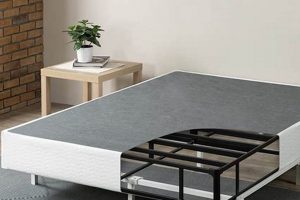A mattress dimension, shorter than the standard queen, provides a specific sleep surface. Commonly measuring 60 inches wide by 75 inches long, it presents a solution for spaces where a standard queen may not fit. For instance, RVs and smaller bedrooms frequently utilize this mattress variation.
The utility of this specific mattress dimension lies in its space-saving properties. It offers a compromise between a full-size and queen-size mattress, providing additional width compared to the former, while maintaining a smaller footprint than the latter. This configuration is particularly advantageous in environments with limited square footage or unusual spatial layouts.
Therefore, understanding spatial constraints is key to selecting the correct mattress. The following sections will delve into further specifications, alternative dimensions, and factors to consider when determining the most suitable mattress for individual needs and bedroom layouts.
Optimizing Sleep Spaces
The subsequent guidelines provide a framework for maximizing comfort and functionality within restricted spaces, addressing mattress selection and room configuration.
Tip 1: Measure Available Space: Prior to any purchase, meticulously measure the intended location for the mattress. Accurate dimensions are crucial to ensure the selected size fits without obstructing movement or access to other furniture.
Tip 2: Consider Room Layout: Analyze the overall room layout. Factor in the placement of doors, windows, and other fixtures. Optimizing these elements will prevent the mattress from impeding access or creating a cluttered feel.
Tip 3: Evaluate Intended Use: Determine the mattress’s primary function. Is it for full-time sleeping, guest accommodation, or recreational vehicle use? The intended purpose will influence the optimal thickness, material, and overall quality of the mattress.
Tip 4: Research Available Brands: Conduct thorough research into various mattress manufacturers and retailers. Compare specifications, customer reviews, and warranty policies to make an informed decision. Prioritize brands known for durability and customer satisfaction.
Tip 5: Check Mattress Specifications: Scrutinize mattress specifications, including dimensions, materials, and construction. Ensure the mattress meets both spatial requirements and desired comfort levels. Consider factors such as firmness, support, and temperature regulation.
Tip 6: Prioritize Comfort and Support: The space-saving aspect should not compromise sleep quality. Research the ideal type of mattress material and construction necessary to promote comfort. Seek out features like reinforced edge support, or cooling technology for the best night’s rest.
Tip 7: Consider Storage Solutions: Evaluate the need for under-bed storage. If desired, select a bed frame that offers integrated storage drawers or ample clearance for storage containers. This can maximize functionality in limited spaces.
Selecting the right mattress size for small spaces requires careful consideration. The steps above provide a solid foundation for making a decision.
Further discussion will explore diverse mattress types, construction methodologies, and the long-term implications of choosing the appropriate sleep surface.
1. Length
The specification of seventy-five inches in length is a defining characteristic that distinguishes a short queen mattress from a standard queen. This dimensional attribute directly impacts the appropriateness of the mattress in specific spatial contexts. Understanding the ramifications of this reduced length is crucial for informed selection.
- Spatial Accommodation
The reduced length primarily addresses spatial limitations, particularly within recreational vehicles (RVs) and smaller bedrooms. This dimension allows for a queen-width sleeping surface without encroaching excessively on available floor space. In RVs, this can mean the difference between maneuverability and constraint. In small bedrooms, it could free up space for other necessary furniture.
- Compromise and Comfort
While providing queen-sized width, the shorter length does necessitate a compromise. Individuals of taller stature may find the seventy-five-inch length insufficient for optimal comfort. Consideration must be given to the user’s height and preferred sleeping position. A taller individual could have their feet dangling off the mattress.
- Bed Frame Compatibility
The seventy-five-inch length dictates the required bed frame dimensions. Standard queen bed frames are not compatible with a short queen mattress. Selecting the proper frame is crucial to ensuring adequate support and preventing premature mattress wear. A standard queen frame would leave a gap at the foot of the bed, or cause the mattress to be improperly supported.
- Market Availability
Due to its specialized nature, a seventy-five-inch length mattress may have limited availability compared to standard sizes. Consumers may need to seek out specific retailers specializing in RV or space-saving solutions. This can impact pricing and selection options. A limited supply can increase costs, or reduce choice of mattress material, construction, or firmness.
The seventy-five-inch length directly correlates with the defining purpose of the short queen mattress. This characteristic is important when evaluating the trade-offs between spatial efficiency, user comfort, and long-term suitability. In summary, considering these details is necessary before the purchase of a “short queen mattress size” mattress.
2. Width
The dimension of sixty inches for width represents a fixed parameter in the definition. This measurement is a key factor in determining the overall utility and suitability of this mattress variant.
- Accommodating Two Sleepers
The sixty-inch width allows for two adults to sleep on the mattress. However, the available space per sleeper is notably less than that of a standard queen or king-size mattress. This can potentially impact sleep quality if co-sleepers have differing sleep styles or sensitivities to movement.
- Space Efficiency vs. Comfort
While maintaining a smaller overall footprint compared to a standard queen, the width offers a trade-off between space efficiency and individual sleeping space. In contexts where maximizing floor space is paramount, the sixty-inch width provides a viable solution. However, individuals prioritizing ample personal space may find this dimension restrictive.
- Bedding and Accessory Considerations
The width dictates the required dimensions for bedding and accessories. Sheets, blankets, and mattress protectors specifically designed for queen-size mattresses are generally compatible. However, consumers should verify compatibility, as variations in manufacturing standards can exist. Incorrectly sized bedding can lead to discomfort or premature wear.
- Impact on Room Aesthetics
The width influences the visual balance and proportionality of a room. In smaller rooms, a sixty-inch-wide mattress may appear proportionally larger compared to the overall space. This can impact the room’s aesthetic appeal and perceived spaciousness. Careful consideration should be given to the placement and surrounding dcor to mitigate any potential visual imbalance.
The specified width is a defining aspect that directly affects both the practical functionality and the perceived comfort. While providing space-saving advantages, this can affect sleep quality. A critical evaluation of these attributes is essential to determine the suitability of this mattress dimension for individual needs and spatial constraints.
3. Space Optimization
The connection between space optimization and a mattress of reduced dimensions is direct and causal. The primary design consideration is efficient utilization of area, particularly in environments where standard-sized mattresses are impractical. This relationship stems from the inherent need to maximize functionality within confined parameters, thereby justifying the deviation from conventional mattress measurements. For example, recreational vehicles, small apartments, and guest rooms often present spatial limitations that preclude the use of larger mattresses. In these scenarios, a shorter mattress becomes not merely preferable but essential for maintaining habitability and maneuverability.
Space optimization, therefore, forms an integral component. Without this focus, the concept of a shortened mattress would lack a fundamental purpose. The reduced length allows for the accommodation of a queen-width sleeping surface while minimizing the mattress’s overall footprint. This strategic compromise has practical significance in various real-world applications, such as allowing for adequate aisle space in RVs or enabling the inclusion of additional furniture in small bedrooms. By adopting these mattresses, individuals can achieve a balance between comfort and functionality, ensuring that limited spaces remain both livable and efficient.
In summary, space optimization is the driving force behind the creation and utilization of a reduced mattress. The connection between the two is not arbitrary but rather based on a practical need to address spatial constraints effectively. This understanding underscores the value of these mattresses in environments where space is at a premium, offering a solution that prioritizes both comfort and efficient area management. The challenge lies in balancing the need for space savings with individual comfort preferences, requiring careful consideration of personal needs and spatial parameters.
4. Recreational Vehicles
The correlation between recreational vehicles (RVs) and a specific mattress dimension arises from the inherent design constraints within these mobile living spaces. Limited interior dimensions necessitate specialized solutions to maximize comfort and functionality. This requirement drives the adoption of non-standard mattress sizes, with a specific mattress frequently employed.
- Spatial Efficiency
RVs are characterized by confined living areas, requiring careful consideration of every component’s dimensions. Standard queen mattresses often prove too large, obstructing movement and limiting available space. This dimension provides a compromise, offering a substantial sleeping surface without unduly compromising interior ergonomics.
- Weight Considerations
Excessive weight negatively impacts fuel efficiency and handling. RV manufacturers and owners prioritize lightweight materials and components to mitigate these effects. This type of mattress, while offering substantial surface area, is generally lighter than its standard counterpart, contributing to overall weight reduction.
- Customization and Adaptability
RV interiors exhibit considerable variation in layout and dimensions. Manufacturers often tailor mattresses to fit specific floor plans and sleeping areas. A smaller mattress offers greater adaptability in accommodating these diverse configurations compared to a standard-sized mattress.
- Accessibility and Maneuverability
Navigating tight corridors and confined spaces within an RV requires unobstructed pathways. Standard-sized mattresses can impede movement, creating safety hazards and reducing overall usability. Choosing the right mattress dimensions ensures adequate accessibility and maneuverability within the living space.
The adoption of a specific mattress dimension in RVs is driven by a confluence of factors, including spatial constraints, weight limitations, customization requirements, and accessibility concerns. These considerations underscore the vital role these mattresses play in enhancing the comfort and functionality of recreational vehicles, enabling occupants to maximize the utility of limited living spaces.
5. Compromise Dimension
The designation of a mattress with reduced length as a “compromise dimension” reflects its role in balancing spatial constraints with the desire for a queen-width sleeping surface. This characterization acknowledges the trade-offs inherent in selecting such a mattress, where maximum space utilization takes precedence over the dimensions of a standard queen-sized bed.
- Spatial Efficiency versus Sleeper Comfort
The primary compromise centers on length. By reducing overall length, the mattress accommodates smaller spaces, such as recreational vehicles or compact bedrooms. This necessitates that taller individuals may experience reduced comfort due to insufficient leg support. The compromise favors spatial efficiency over accommodating the physical dimensions of all potential users.
- Adaptation to Confined Environments
The reduced length allows for greater maneuverability within confined environments, such as RVs. Standard queen mattresses might impede access or movement. This compromise prioritizes the functionality of the space over maximizing the sleeping surface area. This is particularly relevant in mobile living spaces where every inch of available area is critical.
- Cost Considerations
In some instances, these mattresses may offer a cost advantage compared to custom-sized solutions. While not as widely available as standard sizes, a reduced queen often presents a more economical option than commissioning a bespoke mattress. The compromise, therefore, extends to budgetary constraints, offering a balance between cost-effectiveness and spatial adaptability.
- Bedding Compatibility
The width remains consistent with standard queen mattresses, alleviating potential compatibility issues with bedding. Standard queen-size sheets and blankets can typically be used. The compromise focuses on length reduction, minimizing disruption to existing bedding options. This simplifies the purchasing process and reduces the need for specialized accessories.
The description as a “compromise dimension” underscores the importance of carefully evaluating individual needs and spatial limitations. While this mattress offers a practical solution for specific scenarios, potential purchasers must acknowledge and accept the inherent trade-offs involved. Therefore, its “Compromise Dimension” is critical for “short queen mattress size” mattress decisions.
Frequently Asked Questions
The following questions address common inquiries regarding the dimensions and applications of a specific mattress variant.
Question 1: What exact dimensions define a “short queen mattress size?”
This mattress is defined as 60 inches in width and 75 inches in length. These dimensions differentiate it from a standard queen, which typically measures 80 inches in length.
Question 2: In what scenarios is a “short queen mattress size” most suitable?
These mattresses are primarily suitable for recreational vehicles (RVs), campers, and small bedrooms where spatial limitations preclude the use of a standard queen-sized mattress.
Question 3: Are standard queen-size bedding accessories compatible with a “short queen mattress size?”
Most standard queen-size bedding accessories, such as sheets and blankets, are generally compatible due to the shared width dimension. However, excess material may exist due to the shorter length.
Question 4: Does the reduced length of a “short queen mattress size” compromise sleep quality?
The impact on sleep quality depends on the individual’s height. Individuals exceeding 6 feet in height may experience discomfort due to insufficient leg support. Prior evaluation of individual height and sleeping preferences is essential.
Question 5: Are “short queen mattress size” mattresses readily available for purchase?
These mattresses may not be as widely available as standard sizes. Specialized retailers or online vendors catering to RV and small-space solutions are the primary sources for these mattresses.
Question 6: Does a “short queen mattress size” affect bed frame compatibility?
Standard queen-size bed frames are not compatible. A bed frame specifically designed to accommodate the shorter length is required to provide adequate support and prevent damage to the mattress.
In summary, this reduced size mattress offers a practical solution for space-constrained environments. Careful consideration of dimensions, user height, and bed frame compatibility is vital for informed decision-making.
The subsequent section will provide insights into selecting the appropriate mattress firmness and material type for optimal comfort.
Conclusion
The preceding analysis has explored the attributes, applications, and considerations surrounding the reduced-length queen mattress. The dimensions offer a solution for constrained environments, primarily RVs and small bedrooms, where standard sizing proves impractical. However, the inherent compromise in length necessitates careful evaluation of individual needs and potential impact on sleep comfort.
The decision to adopt a reduced-length queen mattress demands a measured approach. Individuals must prioritize spatial requirements alongside personal comfort. The implications of this choice extend beyond mere dimensions, influencing sleep quality and overall functionality of the intended space. Therefore, thorough research, precise measurements, and a comprehensive understanding of user needs are essential for selecting the most appropriate sleep surface.


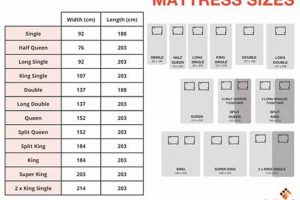
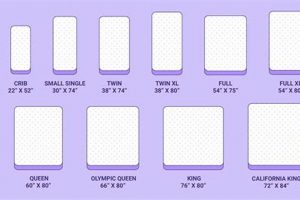
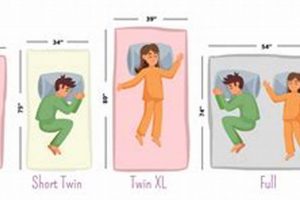
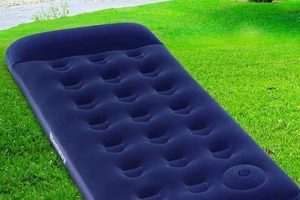
![Best Coleman Queen Size Air Mattress [Guide] Organic & Natural Mattress Buyer’s Guide: Non-Toxic Sleep Solutions Best Coleman Queen Size Air Mattress [Guide] | Organic & Natural Mattress Buyer’s Guide: Non-Toxic Sleep Solutions](https://mattressworldpa.com/wp-content/uploads/2025/07/th-2264-300x200.jpg)
